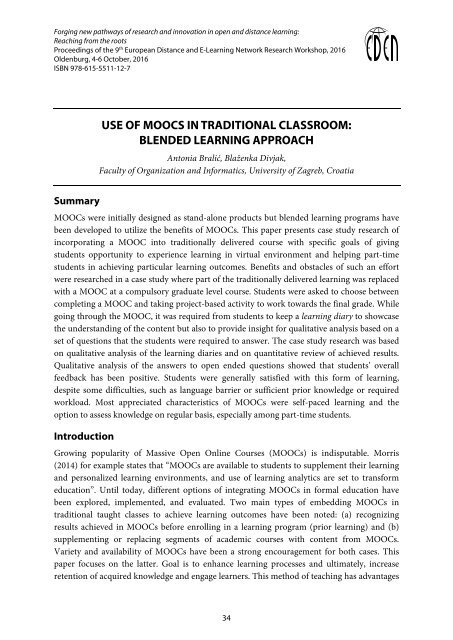Forging new pathways of research and innovation in open and distance learning
RW_2016_Oldenburg_Proceedings
RW_2016_Oldenburg_Proceedings
You also want an ePaper? Increase the reach of your titles
YUMPU automatically turns print PDFs into web optimized ePapers that Google loves.
<strong>Forg<strong>in</strong>g</strong> <strong>new</strong> <strong>pathways</strong> <strong>of</strong> <strong>research</strong> <strong>and</strong> <strong><strong>in</strong>novation</strong> <strong>in</strong> <strong>open</strong> <strong>and</strong> <strong>distance</strong> learn<strong>in</strong>g:<br />
Reach<strong>in</strong>g from the roots<br />
Proceed<strong>in</strong>gs <strong>of</strong> the 9 th European Distance <strong>and</strong> E-Learn<strong>in</strong>g Network Research Workshop, 2016<br />
Oldenburg, 4-6 October, 2016<br />
ISBN 978-615-5511-12-7<br />
USE OF MOOCS IN TRADITIONAL CLASSROOM:<br />
BLENDED LEARNING APPROACH<br />
Antonia Bralić, Blaženka Divjak,<br />
Faculty <strong>of</strong> Organization <strong>and</strong> Informatics, University <strong>of</strong> Zagreb, Croatia<br />
Summary<br />
MOOCs were <strong>in</strong>itially designed as st<strong>and</strong>-alone products but blended learn<strong>in</strong>g programs have<br />
been developed to utilize the benefits <strong>of</strong> MOOCs. This paper presents case study <strong>research</strong> <strong>of</strong><br />
<strong>in</strong>corporat<strong>in</strong>g a MOOC <strong>in</strong>to traditionally delivered course with specific goals <strong>of</strong> giv<strong>in</strong>g<br />
students opportunity to experience learn<strong>in</strong>g <strong>in</strong> virtual environment <strong>and</strong> help<strong>in</strong>g part-time<br />
students <strong>in</strong> achiev<strong>in</strong>g particular learn<strong>in</strong>g outcomes. Benefits <strong>and</strong> obstacles <strong>of</strong> such an effort<br />
were <strong>research</strong>ed <strong>in</strong> a case study where part <strong>of</strong> the traditionally delivered learn<strong>in</strong>g was replaced<br />
with a MOOC at a compulsory graduate level course. Students were asked to choose between<br />
complet<strong>in</strong>g a MOOC <strong>and</strong> tak<strong>in</strong>g project-based activity to work towards the f<strong>in</strong>al grade. While<br />
go<strong>in</strong>g through the MOOC, it was required from students to keep a learn<strong>in</strong>g diary to showcase<br />
the underst<strong>and</strong><strong>in</strong>g <strong>of</strong> the content but also to provide <strong>in</strong>sight for qualitative analysis based on a<br />
set <strong>of</strong> questions that the students were required to answer. The case study <strong>research</strong> was based<br />
on qualitative analysis <strong>of</strong> the learn<strong>in</strong>g diaries <strong>and</strong> on quantitative review <strong>of</strong> achieved results.<br />
Qualitative analysis <strong>of</strong> the answers to <strong>open</strong> ended questions showed that students’ overall<br />
feedback has been positive. Students were generally satisfied with this form <strong>of</strong> learn<strong>in</strong>g,<br />
despite some difficulties, such as language barrier or sufficient prior knowledge or required<br />
workload. Most appreciated characteristics <strong>of</strong> MOOCs were self-paced learn<strong>in</strong>g <strong>and</strong> the<br />
option to assess knowledge on regular basis, especially among part-time students.<br />
Introduction<br />
Grow<strong>in</strong>g popularity <strong>of</strong> Massive Open Onl<strong>in</strong>e Courses (MOOCs) is <strong>in</strong>disputable. Morris<br />
(2014) for example states that “MOOCs are available to students to supplement their learn<strong>in</strong>g<br />
<strong>and</strong> personalized learn<strong>in</strong>g environments, <strong>and</strong> use <strong>of</strong> learn<strong>in</strong>g analytics are set to transform<br />
education”. Until today, different options <strong>of</strong> <strong>in</strong>tegrat<strong>in</strong>g MOOCs <strong>in</strong> formal education have<br />
been explored, implemented, <strong>and</strong> evaluated. Two ma<strong>in</strong> types <strong>of</strong> embedd<strong>in</strong>g MOOCs <strong>in</strong><br />
traditional taught classes to achieve learn<strong>in</strong>g outcomes have been noted: (a) recogniz<strong>in</strong>g<br />
results achieved <strong>in</strong> MOOCs before enroll<strong>in</strong>g <strong>in</strong> a learn<strong>in</strong>g program (prior learn<strong>in</strong>g) <strong>and</strong> (b)<br />
supplement<strong>in</strong>g or replac<strong>in</strong>g segments <strong>of</strong> academic courses with content from MOOCs.<br />
Variety <strong>and</strong> availability <strong>of</strong> MOOCs have been a strong encouragement for both cases. This<br />
paper focuses on the latter. Goal is to enhance learn<strong>in</strong>g processes <strong>and</strong> ultimately, <strong>in</strong>crease<br />
retention <strong>of</strong> acquired knowledge <strong>and</strong> engage learners. This method <strong>of</strong> teach<strong>in</strong>g has advantages<br />
34


